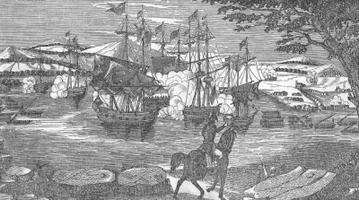The Battle of Ogdensburg
The Battle of Ogdensburg, on 22 February 1813, was a British victory over American forces in the War of 1812. The upper St Lawrence River, a 317-kilometre stretch of majestic waterway from Montréal to Kingston, was the only means to sustain the British and Canadian presence in Upper Canada. If this route were severed, the Americans could cut off forces in Upper Canada. The implications for the British would be disastrous and could ultimately affect their position in British North America. During the first months of the war, the Americans conducted a series of raids between Kingston and Prescott in order to secure supplies for their own use or to disrupt British communication. The British responded to this predatory warfare by staging their own raids into American territory.
Prescott, located 112 kilometres downriver from Kingston, was an important transhipment point where merchantmen exchanged cargo with the bateaux from Montréal. Ogdensburg, New York, lay on the opposite shore. Both villages had military garrisons and regularly exchanged artillery fire or mounted demonstrations against the other. On 4 October 1812, Colonel Robert Lethbridge, the commander at Prescott, undertook an abortive attack on Ogdensburg that sought to clear American troops from the frontier.
Colonel Thomas Pearson, who replaced Lethbridge, pressed his superiors to allow another attempt on Ogdensburg, but to no avail. On 21 February 1813, he made another appeal to Lieutenant-General Sir George Prevost, the commander-in-chief of British North America, who was passing through Prescott on his way to Kingston. Pearson used the recent American raid on Brockville and a threat that the Americans might attempt to capture Prevost to reinforce his argument. Prevost refused to authorize a raid, but gave permission for a minor demonstration that would act as a diversion following his departure. Pearson would not be allowed to undertake this operation, as Prevost ordered him to accompany him to Kingston, where Pearson would take command of the defences. In his stead, Major George Macdonell of the Glengarry Light Infantry was to lead the demonstration after Prevost's departure on the morning of 22 February. Once Prevost reached Brockville, he wrote Macdonell to remind him not to exceed his authority. Macdonell had other ideas and was ready to launch a full-scale attack on Ogdensburg.
The American garrison at Ogdensburg was commanded by Major Benjamin Forsyth, and included his company from the 1st US Regiment of Rifles, four detachments of state militia, several volunteers and eight artillery pieces. The defences included several incomplete minor works, a barracks and the remains of a French fort on the western edge of Ogdensburg.
Battle on Ice
At approximately 7:00 a.m. on 22 February, Macdonell formed his men on the frozen river. The Americans took no action as the British regularly drilled on the ice. The attackers included 480 regulars and militia who were split into two columns, each supported by guns mounted on sleighs. The right column, under Captain John Jenkins of the Glengarry Light Infantry Fencibles, included a company of infantry and 70 militiamen. They were to move against the American left and cut off their retreat. The larger left column was under Macdonell and included 150 men from the 8th Foot, 30 from the Royal Newfoundland Regiment and 230 militiamen. As Forsyth watched the British continue across the river, he realized that they were going to attack and readied his men.
The river was just under 2 km wide. The ice and snow impeded the advance of both columns. Once halfway across the river, both columns came under artillery fire. Jenkins' slow-moving column ran into heavy opposition at the old French fort. Jenkins was severely wounded and despite the efforts of Lieutenant James Macaulay to renew the advance, the column fell into disorder and withdrew. Macdonell's column faced less resistance and soon entered the town. Forsyth saw he was outnumbered and at his order his men withdrew, eventually making their way to Sackets Harbor.
Aftermath of the Battle of Ogdensburg
With the enemy gone, the final reduction of the military post at Ogdensburg was now undertaken. Several schooners and gunboats trapped in the frozen ice were put to flame, and the military stores, 11 guns and other public property were either destroyed or taken to Prescott. British losses included eight killed and 52 wounded. The Americans suffered five killed, 15 wounded and 75 captured.
Whatever animosity the raid may have sparked with the local populace was short lived. Soon after the attack, commerce between Prescott and Ogdensburg recommenced, while leading citizens from both sides entertained one another at dinner parties. News of the victory reached Prevost that evening and he was so elated that he sent a note of congratulations to Macdonell. The British achieved lasting success by removing the primary threat to their communication on the upper St Lawrence. Ogdensburg was not garrisoned for the balance of the war. The communication on the upper St Lawrence remained under British control for the remainder of the war, except for a brief period during Major-General Wilkinson's expedition to Montréal in November.

 Share on Facebook
Share on Facebook Share on X
Share on X Share by Email
Share by Email Share on Google Classroom
Share on Google Classroom





